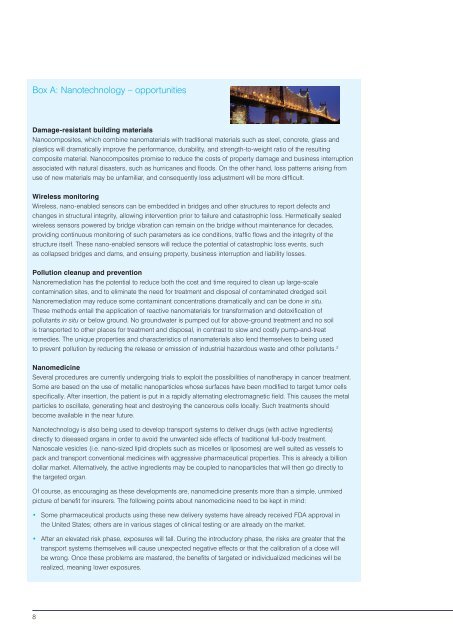Nanotechnology - Nanowerk
Nanotechnology - Nanowerk
Nanotechnology - Nanowerk
You also want an ePaper? Increase the reach of your titles
YUMPU automatically turns print PDFs into web optimized ePapers that Google loves.
Box A: <strong>Nanotechnology</strong> – opportunities<br />
Damage-resistant building materials<br />
Nanocomposites, which combine nanomaterials with traditional materials such as steel, concrete, glass and<br />
plastics will dramatically improve the performance, durability, and strength-to-weight ratio of the resulting<br />
composite material. Nanocomposites promise to reduce the costs of property damage and business interruption<br />
associated with natural disasters, such as hurricanes and floods. On the other hand, loss patterns arising from<br />
use of new materials may be unfamiliar, and consequently loss adjustment will be more difficult.<br />
Wireless monitoring<br />
Wireless, nano-enabled sensors can be embedded in bridges and other structures to report defects and<br />
changes in structural integrity, allowing intervention prior to failure and catastrophic loss. Hermetically sealed<br />
wireless sensors powered by bridge vibration can remain on the bridge without maintenance for decades,<br />
providing continuous monitoring of such parameters as ice conditions, traffic flows and the integrity of the<br />
structure itself. These nano-enabled sensors will reduce the potential of catastrophic loss events, such<br />
as collapsed bridges and dams, and ensuing property, business interruption and liability losses.<br />
Pollution cleanup and prevention<br />
Nanoremediation has the potential to reduce both the cost and time required to clean up large-scale<br />
contamination sites, and to eliminate the need for treatment and disposal of contaminated dredged soil.<br />
Nanoremediation may reduce some contaminant concentrations dramatically and can be done in situ.<br />
These methods entail the application of reactive nanomaterials for transformation and detoxification of<br />
pollutants in situ or below ground. No groundwater is pumped out for above-ground treatment and no soil<br />
is transported to other places for treatment and disposal, in contrast to slow and costly pump-and-treat<br />
remedies. The unique properties and characteristics of nanomaterials also lend themselves to being used<br />
to prevent pollution by reducing the release or emission of industrial hazardous waste and other pollutants. 2<br />
Nanomedicine<br />
Several procedures are currently undergoing trials to exploit the possibilities of nanotherapy in cancer treatment.<br />
Some are based on the use of metallic nanoparticles whose surfaces have been modified to target tumor cells<br />
specifically. After insertion, the patient is put in a rapidly alternating electromagnetic field. This causes the metal<br />
particles to oscillate, generating heat and destroying the cancerous cells locally. Such treatments should<br />
become available in the near future.<br />
<strong>Nanotechnology</strong> is also being used to develop transport systems to deliver drugs (with active ingredients)<br />
directly to diseased organs in order to avoid the unwanted side effects of traditional full-body treatment.<br />
Nanoscale vesicles (i.e. nano-sized lipid droplets such as micelles or liposomes) are well suited as vessels to<br />
pack and transport conventional medicines with aggressive pharmaceutical properties. This is already a billion<br />
dollar market. Alternatively, the active ingredients may be coupled to nanoparticles that will then go directly to<br />
the targeted organ.<br />
Of course, as encouraging as these developments are, nanomedicine presents more than a simple, unmixed<br />
picture of benefit for insurers. The following points about nanomedicine need to be kept in mind:<br />
• Some pharmaceutical products using these new delivery systems have already received FDA approval in<br />
the United States; others are in various stages of clinical testing or are already on the market.<br />
• After an elevated risk phase, exposures will fall. During the introductory phase, the risks are greater that the<br />
transport systems themselves will cause unexpected negative effects or that the calibration of a dose will<br />
be wrong. Once these problems are mastered, the benefits of targeted or individualized medicines will be<br />
realized, meaning lower exposures.<br />
8<br />
_013ZC_131887A01.indd 8 03/11/2010 10:38
















